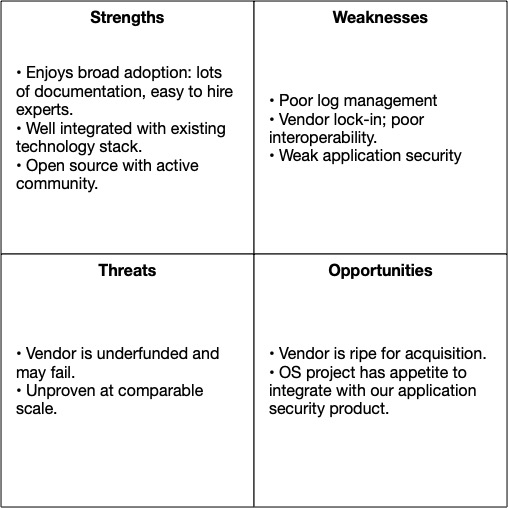Please stop fighting
A debate, even when heated, can result in insight, clarity, and a unified decision. Unfortunately, when a debate gets heated it is easy to make up our mind, lock into a position, and begin defending a viewpoint rather than working towards a solution. I believe that having tools to avoid bunkering helps pivot to productive conversation. This brief post describes two approaches I have used successfully over the years: the Hot Debate Document and a SWOT Analysis.
Hot Debate Document (HDD)
An HDD is a useful tool to make progress when people struggle to agree. The goal of such a document is to capture both sides of the discussion fully and clearly. It makes no attempt to evaluate the merits of any viewpoint, nor to drive to consensus or decision. It is purely intended to capture the essence of a disagreement. Note that this assumes only a pair of opposing viewpoints, as is most common, but the approach can be applied to any number of competing positions.
The document should be short, ideally three paragraphs and rarely more than a single page. Authorship of the document is shared between two authors, a collaboration from both sides of the disagreement.
It is structured into three sections. The first section is brief, often no more than a single sentence, and simply describes the topic of the debate. It is rarely difficult for the two authors to agree on this section. Then the authors independently write the next two sections, expressing their perspective to the best of their ability. When they have finished, each reviews and helps improve the other section for clarity.
That’s it!
It is not uncommon that simply creating an HDD can resolve the debate. The most successful outcome for an HDD is that it is never seen by anyone other than the authors, and this is pretty common in practice. Many unproductive debates spring from unstated assumptions or differing interpretations of terminology; writing them down can unveil the misunderstanding and unblock progress. In other cases, where there is real and substantive disagreement, the debate document may serve to clarify the trade-offs and give insight that results in a decision (see SWOT Analysis below). However, even in situations where a debate remains unresolved, an HDD is an excellent starting point for engaging more participants, often by escalating to the appropriate leader who can add clarity, or if appropriate simply impose a decision.
SWOT Analysis
When a truly complex or difficult decision must be reached, a brief HDD is unlikely to be sufficient. Some issues require careful evaluation of two (or more) competing options, and so expanding the HDD with thorough analysis is useful. A common approach to this type of analysis the “pros and cons” list, used to describe the comparative advantages and disadvantages of each option. In my experience the problem with “pros and cons” is that they are converse of one another. Such lists are typically repetitive, as one option’s con is typically another option’s pro.
I have found it more productive to utilize a more rigorous analysis known as a SWOT: Strengths, Weaknesses, Opportunities, Threats.  Such an analysis is often summarized in a four-blocker, making it easy to consume. Note that the positioning of each section is careful. It facilitates direct comparison between strengths and either weaknesses or threats, and notes that weaknesses and threats often breed opportunities.
Such an analysis is often summarized in a four-blocker, making it easy to consume. Note that the positioning of each section is careful. It facilitates direct comparison between strengths and either weaknesses or threats, and notes that weaknesses and threats often breed opportunities.
Strengths and weaknesses are somewhat self-explanatory. The Threats section is intended to capture downside risks associated with the option, including both inherent concerns for which mitigation is possible, and external risks that are out of direct control. The Opportunities section captures additional considerations that may not be directly related to the decision but are unlocked by the option.
The following small and entirely fictional SWOT chart is presented to help clarify the distinctions and relationships. Note the top threat is also represented as an opportunity; the final weakness similarly offers an opportunity.

Hope this helps!

“…. each of the authors independently writeS the next two sections…..”
(ie Each WRITES).
I really agreed and respected your cerebral approach to disagreement. The problem, ever increasing it seems, is that disagreement results in anger. Perhaps the backdrop might be that ancient but ever valid quote: “Those whom the Gods would destroy they first make angry!”
Sigh. No matter how many times you proofread….
Thanks, Dad. Glad you appreciated the post! It’s a great and appropriate post but for some reason my site refuses to let me add it. I’ll try again tomorrow. [rolling my eyes]